This is a growing market with new innovations that are not only able to protect our property and improve commercial insights, but also significantly improve the ease of system deployment and management at much lower cost structures—broadening the use case for professional video surveillance.
Within the professional/commercial sector, small- and medium-sized businesses (SMBs) are a rapid growth driver. SMB use cases include retail stores like restaurants and shops, small/medium-size offices, health care clinics, school campuses, small hotels and apartment communities, etc.
Video storage is a critical element in today’s surveillance systems. Choosing the right video storage solution requires a detailed understanding of the requirements, tradeoffs and options available for SMBs. This brief discusses the total cost of ownership (TOC) implications of different storage solutions currently promoted in the SMB market.
Storage Solutions for Small- and Medium-Sized Businesses (SMBs)
Generally, there are five types of storage solutions for an SMB:
- Standalone Network Video Recorder (NVR)
The video stream generated by an IP camera is transmitted and stored in an onsite standalone NVR system, which consists of dedicated embedded hardware with built-in surveillance-specific software and storage media, typically hard disk drives (HDDs).
- Network Attached Storage (NAS)
The video stream generated by an IP camera is transmitted and stored in an onsite NAS system, which is a file-level computer data storage system with add-on surveillance software, typically using HDDs as storage media.
- PC-based Recorder
The video stream generated by an IP camera is transmitted and stored in an onsite PC-based recorder. This recorder typically uses off-the-shelf PC hardware with built-in or customer-installed video management software and hard disk drives as storage media.
- Cloud Storage
The video stream generated by IP camera will be transmitted and stored onto a remote cloud storage space, typically available as a subscription service from various public or private cloud vendors.
- Edge Storage
The video stream generated by an IP camera is stored in the IP camera itself, using a flash-based microSD memory card. This minimizes the need for continuous use of the network to transmit data to central on-site or offsite/cloud locations.
Typically, the location of the video management software (VMS) indicates the management architecture of the system. As shown in Figure 1, with standalone NVR, NAS or PC-based recorders, there is usually a physical on-premise appliance that acts as the primary way to manage cameras and the entire system, and it requires software upgrades and associated IT management. With cloud and edge storage solutions, the VMS typically runs in the cloud; therefore, the overall architecture is designed from the ground up for ease of remote management, eliminating the need for dedicated, local management and storage appliances and associated IT management overhead.
While the above five scenarios are typical system designs, they are not the only system designs. Project-specific requirements can lead to many hybrid approaches that span multiple types of storage and management options.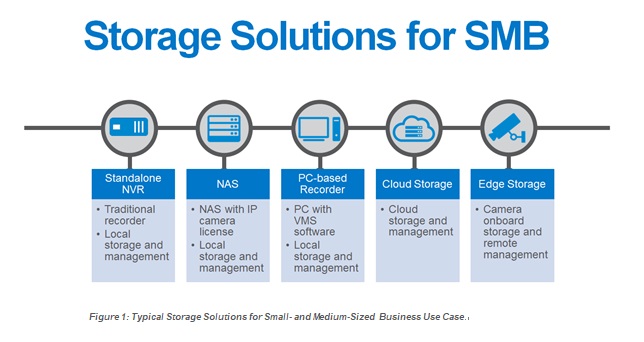
Storage Requirements for SMB
To simulate a TCO model for an SMB use case, we analyzed three scenarios:
- Scenario 1: Convenience Store
Typically, a small retail shop can require up to 4 IP camera units to cover critical areas (checkout counter, storage, entry, goods) with at least 2-4 weeks of recorded video archives.
Configuration: 4 channels of 1080p IP camera connections with 30 days storage capacity (1TB storage capacity required). - Scenario 2: Gas Station
Generally, a gas station can require up to 8 IP camera units to cover critical areas (fuel dispensers, office, shop, checkout counter, etc.) with at least 2-4 weeks of recorded video archives.
Configuration: 8 channels of 1080p IP camera connections with 30 days storage capacity (2TB storage capacity required). - Scenario 3: Small/Medium-Sized Office Buildings
In certain cases, up to 16 IP camera units may be needed to cover critical areas (reception desk, warehouse, public office area, parking lot, etc.) with at least 2-4 weeks of recorded video archives.
Configuration: 16 channels of 1080p IP camera connections with 30 days storage capacity (4TB storage capacity required).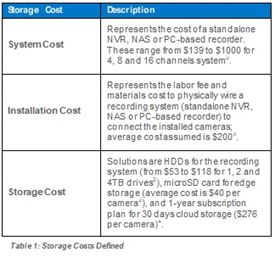
What Does “Storage Cost” Mean?
Typically, when we consider the storage cost for a video surveillance system, a hard disk drive is the first item we think about. However, when considering total cost, we also need to consider the cost of the recording system and the incremental cost to install a hard-wired system. Therefore, total storage cost should include: system cost + installation cost + storage cost.
Storage Cost Analysis
Based on the requirements of the three storage requirement scenarios outlined previously (with 4/8/16 channel connections), we estimated the total storage cost for each storage solution (Figure 2).
According to our storage cost analysis (Figure 3), edge storage is the most competitive solution from a TCO perspective, followed by standalone NVR, NAS, PC-based recorder and cloud storage.
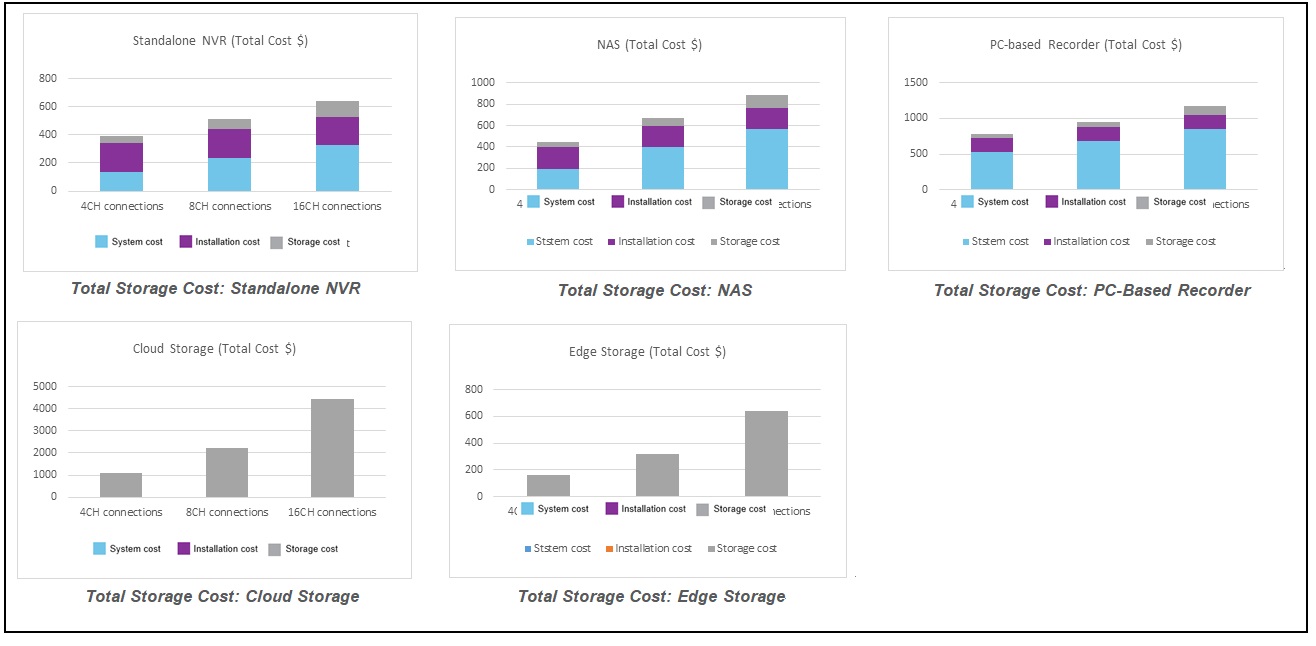
Figure 2: Total Storage Cost by Storage Scenario
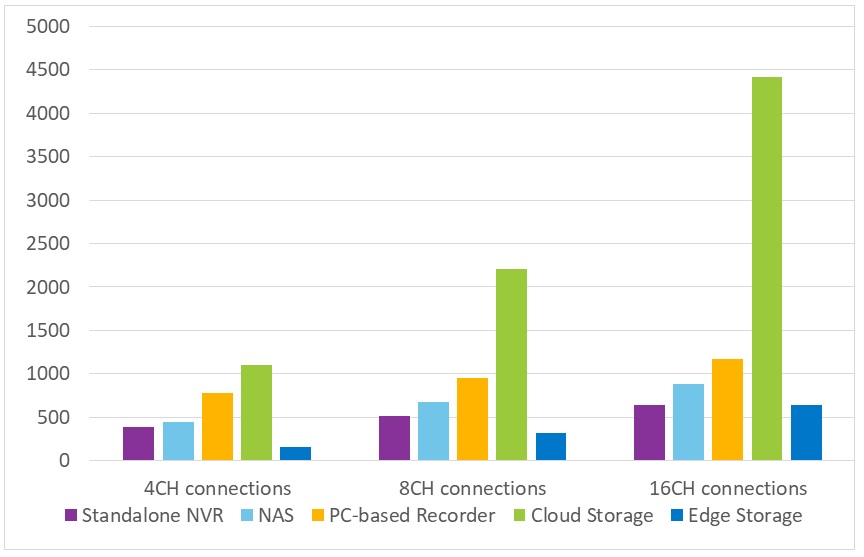
Figure 3: Storage Cost Analysis
Edge Storage-Based Systems: Better Benefits, Value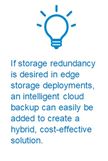
In addition to cost benefits, edge storage is easy to deploy, manage and scale because on-site recording systems are not required. Because primary video footage is stored locally in the camera, these systems require less network bandwidth and avoid cloud storage costs, offering better scalability and TCO compared to cloud-only storage solutions. These benefits make edge storage a preferred choice for many system integrators and end customers. Additionally, because video stays in the camera/on-premise, privacy concerns associated with cloud-based storage are reduced.
Table 2 provides a side-by-side overview of total solution costs and benefits for various storage solutions. Generally, while a cloud-based management system is highly effective and is beneficial for SMBs, project-by-project specifics may require a combination of these systems to achieve an optimized solution.
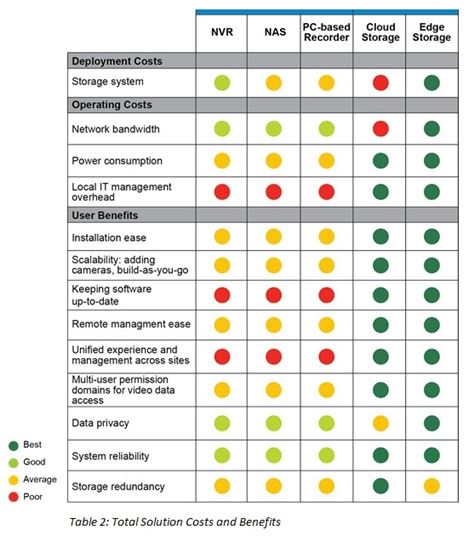
How to Select the Right Edge Storage Solution
As edge storage grows in popularity, selecting the right solution is important. Some items to consider are:
- Storage Capacity
Is the edge storage solution able to store up to 2 weeks, or even 1 month, of video archives at the target resolution with the chosen compression techniques? In today’s video surveillance industry, 1080p resolution is a basic requirement for an IP camera (4K is on the way). With continuous recording of high-quality surveillance video, a higher-density storage device will be needed to meet data storage and archiving requirements.
Endurance and QualityWill the edge storage solution have the rigor and design longevity to last three or more years in the field? Typical surveillance solutions need to be ruggedized, even all-weather resistant. To reduce maintenance and decommission costs during service years and to help control TCO, a high-endurance device with surveillance-grade edge storage is critical.
- Remote Manageability
Does the IP camera support direct remote management, live viewing, video playback while being fully optimized with an onboard memory card? Because no additional NVR or gateway connection is needed between an IP camera and remote applications, an IP camera should be capable of supporting remote management and live/archived video streaming from a mobile app or a web portal. In addition, active alert notifications are required.
Spotlight: Vivotek Surveillance-Grade Edge Storage Solution
Vivotek, a leading manufacturer in the IP surveillance industry, offers IP surveillance solutions optimized with Micron’s industrial microSD card. Targeted at SMB surveillance-grade edge storage solutions, this system offers:
- Full IP camera product portfolios: Vivotek offers a wide range of high-quality IP surveillance camera solutions that cover all SMB use cases – from indoor to outdoor, HD to UHD quality, and equipment with advanced features.
- Viewing/managing anytime, anywhere: Vivotek’s Vivo-Cloud service enables users to remotely monitor and manage Vivotek IP cameras from a mobile app/web portal on a smartphone or personal computing device. Vivo-Cloud can support up to 16 connected IP cameras with key features such as easy setup, shared devices, timeline playback, push notification, fisheye dewarp, etc.
- Surveillance-grade microSD card: Micron’s industrial microSD cards are specifically designed for IP video surveillance workloads. The cards offer storage densities up to 256GB, which enables more days of video stored at the edge. Additionally, the cards support over 3 years of high-quality, continuous, 24x7 video recording5 in a wide range of temperatures and environments.
- Predictive maintenance: With integrated technology that enables the microSD cards to self-monitor and report card usage information and expected useful life remaining, users will receive an alert notification from the Vivotek IP camera6 in advance if replacement is necessary.
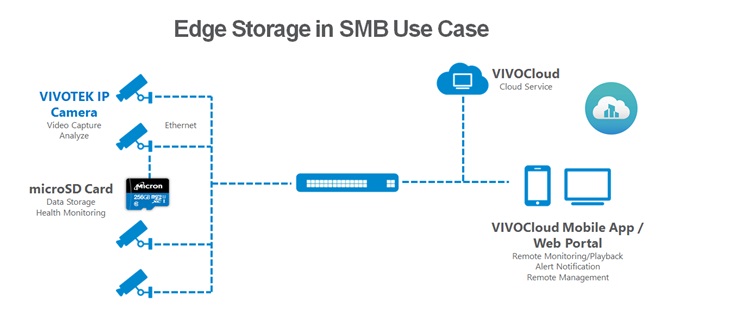
Smart, Reliable, Secure
Edge storage-based solutions are an excellent, low TCO choice for SMB use cases. For your next security project, consider implementing an edge storage solution with Micron’s surveillance-grade edge storage solutions.
Learn more: at www.micron.com/campaigns/video-surveillance
References
[1] IDC Worldwide Surveillance Camera and Storage 2017-2021 Forecast
[2] Price information from etailers and vendor’s MSRP
[3] Price information: Fixr.com (Hardwired Computer Network Cost)
[4] Price information: IPVM (Cloud Video Surveillance Providers)
[5] Micron lab test data-based, with up to 8 Mb/s video bit rate for 256GB microSD card
[6] Vivotek IP camera support list: https://www.vivotek.com/micron_sd


















